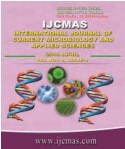


 National Academy of Agricultural Sciences (NAAS)
National Academy of Agricultural Sciences (NAAS)

|
PRINT ISSN : 2319-7692
Online ISSN : 2319-7706 Issues : 12 per year Publisher : Excellent Publishers Email : editorijcmas@gmail.com / submit@ijcmas.com Editor-in-chief: Dr.M.Prakash Index Copernicus ICV 2018: 95.39 NAAS RATING 2020: 5.38 |
Ear infections usually results from bacterial, fungal, viral infections. Ear infections are major health problem and occur with a high incidence and prevalence in both developed and developing countries which leads to deafness and intra-cranial complications. It may be acute, chronic or recurrent. It can be suppurative or non-suppurative. The Aim of study is to determine Bacterial and Mycological profile and their antimicrobial sensitivity pattern of Ear Infections. Total 95 patients of Ear Infections are included in this study. Swabs were taken and sent immediately to the microbiology laboratory and processed. Bacterial and Fungal isolates were identified using standard methods and antibiotic susceptibility testing was done. Pseudomonas aeruginosa 21 (44%) was the most predominant bacterial isolate followed by Staphylococcus aureus 16 (34 %). Among fungi, Aspergillus niger 10 (16%) was common isolate, followed by Candida albicans 2 (3%). The study of microbial pattern and their antibiotic sensitivity determines the prevalent bacterial organisms causing Ear Infections in local area and to start its empirical treatment and complications for successful outcome, thus to prevent the emergence of resistant strains.
 |
 |
 |
 |
 |